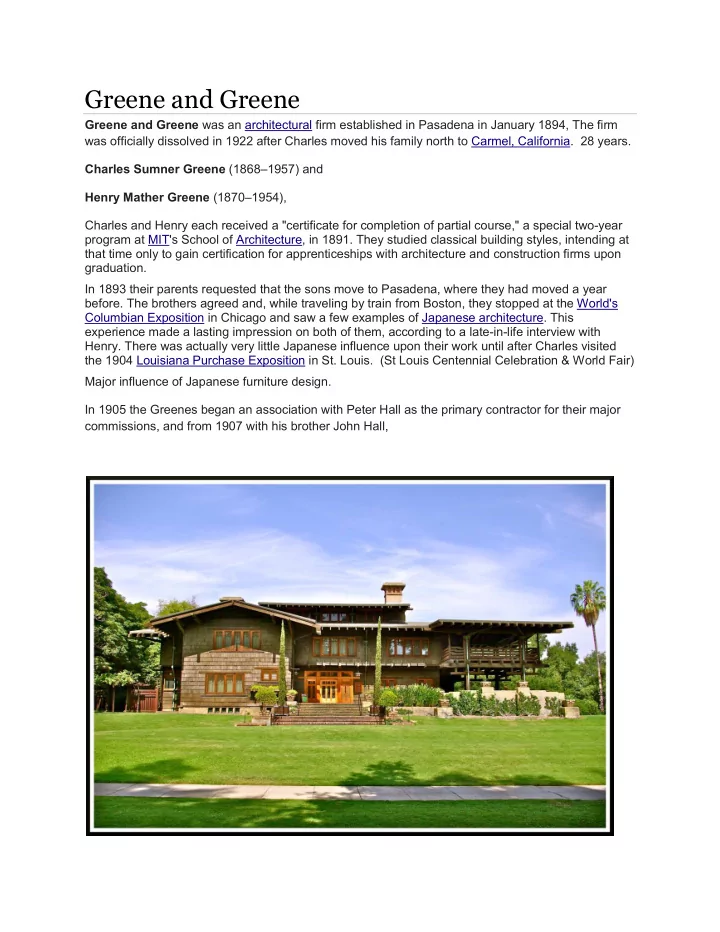

Greene and Greene Greene and Greene was an architectural firm established in Pasadena in January 1894, The firm was officially dissolved in 1922 after Charles moved his family north to Carmel, California. 28 years. Charles Sumner Greene (1868–1957) and Henry Mather Greene (1870–1954), Charles and Henry each received a "certificate for completion of partial course," a special two-year program at MIT's School of Architecture, in 1891. They studied classical building styles, intending at that time only to gain certification for apprenticeships with architecture and construction firms upon graduation. In 1893 their parents requested that the sons move to Pasadena, where they had moved a year before. The brothers agreed and, while traveling by train from Boston, they stopped at the World's Columbian Exposition in Chicago and saw a few examples of Japanese architecture. This experience made a lasting impression on both of them, according to a late-in-life interview with Henry. There was actually very little Japanese influence upon their work until after Charles visited the 1904 Louisiana Purchase Exposition in St. Louis. (St Louis Centennial Celebration & World Fair) Major influence of Japanese furniture design. In 1905 the Greenes began an association with Peter Hall as the primary contractor for their major commissions, and from 1907 with his brother John Hall,
The architectural firm of Greene and Greene was established in Pasadena in January 1894, eventually culminating with the designs of their "ultimate bungalows", such as the 1908 Gamble House in Pasadena, generally considered one of the finest examples of residential architecture in the United States.
Two other landmark ultimate bungalows were the Robert R. Blacker House in Pasadena and the Thorsen House. Such ultimate bungalows were completely custom affairs, where the vast majority of elements—light fixtures, furniture, even woven textiles—were created for specific spaces in the home.
Gamble House entry table http://www.finewoodworking.com/readerproject/2009/01/15/gamble-house-entry-table-2 Finger joints and ebony detailing on my version of the entry hall table from the Gamble house by Greene & Greene. The brass pins are screws with the heads cut down as on the original.
The Greenes were masters of relief . Every structural element exists in its own plane and is rounded over before stepping down to the next level. Drawer handle, these cloud lifts are large and bold. The ebony plugs look like structural components, but they’re just decorative. REFERENCES :- WIKIPEDIA https://en.wikipedia.org/wiki/Greene_and_Greene GAMBOL HOUSE - MUSEUM :- http://gamblehouse.org/ SMITHSONIAN :- https://www.smithsonianmag.com/arts-culture/the-splendor-of-greene-and-greene-99009658/ DESIGN WITHOUT COMPROMISE :- http://www.blueridgewoodwork.com/wp-content/uploads/2016/12/GreeneGreeneHR.pdf CRAFTSMANS BUNGALOW :- http://www.thecraftsmanbungalow.com/gamble-house-interior/ DARREL PERT - REPRODUCTION GREEN & GREEN FURNITURE - SEE GALLERY http://furnituremaker.com/
Recommend
More recommend